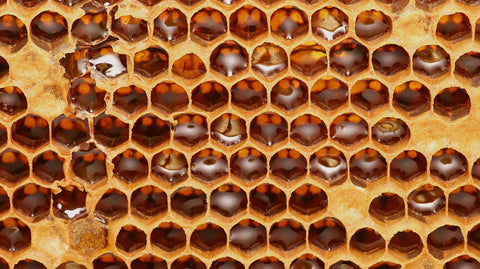Beeswax candles are made by melting beeswax and pouring it into a mold or container around a wick. The melted wax is then allowed to cool and harden, creating a candle.
Beeswax candles have a timeless charm that sets them apart from the rest. With their warm golden glow, naturally sweet scent, and clean, long-lasting burn, it's no wonder they've become a favorite among candle lovers who value quality and sustainability.
Unlike synthetic candles made from paraffin or soy blends, beeswax candles are created from a completely natural byproduct of beekeeping, making them both beautiful and eco-friendly.
But how exactly do these unique candles come to life? While the process can be as simple or as detailed as a candle maker wants it to be, the basics remain the same: bees make the wax, and artisans gently transform it into something special.
In this post, we’ll walk through what beeswax is, how it’s turned into candles, and why these golden beauties are worth adding to your home.
What Is Beeswax?
Beeswax is a completely natural substance produced by honeybees during the process of building their hives. Young worker bees secrete the wax from special glands and shape it into cells to store honey and raise their young. These wax cells are incredibly strong, naturally antimicrobial, and slightly sticky, perfect for the busy life of a bee colony.
When beekeepers harvest honey, they also collect the thin wax caps that seal each honeycomb cell. The result is a beautifully golden, sweet-smelling wax that retains many of its natural properties, including its subtle fragrance and non-toxic composition. This leftover wax is carefully cleaned and repurposed to make a variety of products, including candles.
Unlike paraffin or soy-based waxes, beeswax doesn’t require synthetic additives or chemical processing. With its light golden color, subtle honey aroma, and non-toxic properties, beeswax is one of the cleanest and most natural materials you can burn in your home.
From Hive to Candle: The Basics of Beeswax
Turning beeswax into a candle is a surprisingly simple process, especially when compared to other types of wax that often require chemical additives or blending. It all begins in the hive, where bees produce wax to construct honeycomb. After honey is harvested, beekeepers collect the wax cappings left behind. These wax pieces are then melted down, usually in a double boiler, and strained to remove any bits of honeycomb, pollen, or debris.
Once the wax is clean and pure, it’s ready to be transformed. Depending on the desired candle style, the wax may be poured into molds or containers, hand-dipped for classic tapers, or rolled into sheets for a rustic, textured look.
A cotton or wood wick is placed at the center, and as the wax cools and solidifies, it forms a naturally beautiful, long-burning candle. The process highlights the purity and simplicity of beeswax, just one ingredient, thoughtfully prepared, from hive to home.
Why People Love Beeswax Candles
Beeswax candles have earned a loyal following for good reason. First and foremost, they’re one of the cleanest-burning candle options available. Because beeswax is naturally free of toxins and additives, it doesn’t release harmful chemicals into the air like some paraffin-based candles can.
Beyond health benefits, beeswax candles offer a warm, natural glow and a subtle honey-like scent that comes straight from the hive, no artificial fragrances needed. They also burn longer and drip less than many other candle types, making them both economical and low-maintenance.
Whether used for relaxation, ambiance, or simply to enjoy a touch of nature indoors, beeswax candles are loved for their beauty, simplicity, and connection to the natural world. Plus, choosing beeswax supports a sustainable craft that naturally encourages ethical beekeeping, a topic we’ll explore more in the next section.
Supporting Bees and Sustainability
When you choose beeswax candles, you're doing more than just picking a natural product, you’re also supporting the health of our environment and the future of beekeeping.
Responsible beekeepers play a crucial role in maintaining healthy bee populations, which are essential for pollinating crops and sustaining ecosystems. By purchasing beeswax products, you're helping to create demand for ethical beekeeping practices that prioritize the wellbeing of the hive.
Beeswax is also a naturally renewable resource. Unlike synthetic waxes made from petroleum, beeswax is produced as part of a healthy hive’s normal activity and requires minimal processing. This makes it one of the most eco-friendly candle options available.
Supporting beeswax candles means supporting a small, sustainable cycle: one that benefits beekeepers, bees, and the planet.
Final Thoughts About Beeswax Candles
Beeswax candles offer more than just a beautiful, long-lasting glow, they represent a return to natural, sustainable living. Made with minimal processing and no additives, they’re a cleaner choice for your home and a gentle way to support the hardworking bees that make them possible.
At Ames Farm, we take pride in crafting pure beeswax candles using wax from our own ethically managed hives. Each candle reflects our commitment to natural beekeeping and sustainable practices. When you choose an Ames Farm beeswax candle, you're not just lighting a room, you’re supporting local bees, real beekeepers, and a healthier planet.
Frequently Asked Questions About Beeswax Candles
What makes beeswax candles different from other candles?
Beeswax candles are made from natural wax produced by honeybees, unlike paraffin candles, which are petroleum-based. They burn cleaner, last longer, and have a natural honey scent without added fragrances.
Do bees get harmed during the harvesting of beeswax?
When sourced from ethical beekeepers like those at Ames Farm, bees are not harmed. Only surplus wax is harvested, and the health of the hive is always prioritized.
Do beeswax candles have a scent?
They have a light, natural scent that smells slightly sweet, like honey. This scent comes from the pollen and nectar found in the wax and is not artificially added.



